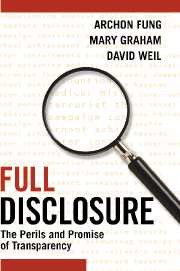Book contents
- Frontmatter
- Dediaction
- Contents
- List of Figures and Tables
- Preface
- 1 Governance by Transparency
- 2 An Unlikely Policy Innovation
- 3 Designing Transparency Policies
- 4 What Makes Transparency Work?
- 5 What Makes Transparency Sustainable?
- 6 International Transparency
- 7 Toward Collaborative Transparency
- 8 Targeted Transparency in the Information Age
- Appendix: EighteenMajor Cases
- Notes
- Bibliography
- Index
2 - An Unlikely Policy Innovation
Published online by Cambridge University Press: 27 July 2009
- Frontmatter
- Dediaction
- Contents
- List of Figures and Tables
- Preface
- 1 Governance by Transparency
- 2 An Unlikely Policy Innovation
- 3 Designing Transparency Policies
- 4 What Makes Transparency Work?
- 5 What Makes Transparency Sustainable?
- 6 International Transparency
- 7 Toward Collaborative Transparency
- 8 Targeted Transparency in the Information Age
- Appendix: EighteenMajor Cases
- Notes
- Bibliography
- Index
Summary
The emergence of targeted transparency as mainstream policy represents an unlikely political innovation. In recent years, national, state, local, and international policymakers have overcome political obstacles to require both private-sector organizations and public agencies to collect and share new facts about the risks they create and the quality of their performance. Legislators have mandated new transparency despite enduring values and political interests that usually favor secrecy. They have also overcome the resistance to innovation that generally characterizes democratic systems of government. Their actions are all the more surprising because they have invented new transparency systems without any central direction and usually without knowledge that their actions are contributing to a broader policy change.
In this chapter we explore why such an unexpected development in governance has occurred at this moment in history by examining the growth of targeted transparency policies in the United States in recent decades. We begin by documenting the frequency with which targeted transparency has been legislated in recent years across many major policy areas.
We then review the development of government-mandated transparency in the United States. We find that three factors have helped to propel this new generation of transparency into mainstream policy. First, the maturing of an early generation of right-to-know transparency measures helped to prepare the way for targeted transparency policies. Second, crises that called for urgent responses to suddenly revealed risks or performance problems helped to overcome political forces that favored secrecy and that limited innovation.
Information
- Type
- Chapter
- Information
- Full DisclosureThe Perils and Promise of Transparency, pp. 19 - 34Publisher: Cambridge University PressPrint publication year: 2007
- Creative Commons
- This content is Open Access and distributed under the terms of the Creative Commons Attribution licence CC-BY-NC 4.0 https://creativecommons.org/cclicenses/
